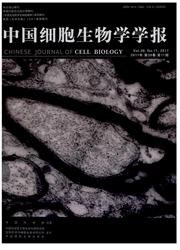

 中文摘要:
中文摘要:
细胞在受到内源、外源的氧化物刺激时均能启动应答机制,改变蛋白质的量、定位和活性来抵抗应激。作者前期的研究发现,SUMO特异蛋白酶SENP3(Sentrin/SUMO specific protease3)可以感受一定程度的氧化应激而发生量的累积,从而影响一系列转录因子的SUMO化修饰状态和特异基因表达,发挥应答应激的功能,但在不同程度氧化应激时SENP3是否有不同的感受和应答机制并不清楚。该研究应用不同剂量H2O2模拟不同程度氧化应激,探讨SENP3的量、定位改变和对抗氧化蛋白表达的影响。结果显示,轻度氧化应激即可造成SENP3量的增加,但无H2O2剂量相关关系,而不同程度氧化应激均可引起SENP3从核仁向核质的移位,且随H2O2剂量增加而增加。在氧化应激引起的过氧化物氧还蛋白4(peroxiredoxin 4,Prx4)、超氧化物歧化酶1(superoxide dismutase1,SOD1)及过氧化氢酶(catalase,CAT)表达上调中,SENP3介导了这种表达改变,且有H2O2剂量相关性。该研究一方面发现了SENP3感受不同程度氧化应激的两种机制,另一方面也发现了SENP3介导抗氧化应答的功能,提示SENP3在细胞精细的应激应答机制中扮演了重要角色,具有一定的生理和病理意义。
 英文摘要:
英文摘要:
In response to oxidation stress, proteins would alter their quantity, localization and activity to prevent from oxidative damage. Our previous study already discovered that SENP3(Sentrin/SUMO specific protease 3) sensed certain extent of oxidative stress via inhibiting degradation and then giving rise to alteration of sumolylation of transcription factors, by which tumor obtained potential of proliferation and migration. However, how SENP3 senses and makes responses to distinct extents of oxidative stress are unclear. In the present study, we treated tumor cells with different doses of hydrogen peroxide(H2O2) to mimic different extent of oxidative stress and therefore detected the quantity and localization of SENP3 and further analyzed the changes of antioxidants expression affected by SENP3. The results showed that SENP3 exhibited quick accumulation under low level of H2O2 and other levels of H2O2 in a dose independent manner. Notably, SENP3 also translocated from nucleolus to nucleoplasm upon H2O2 in dose dependent manner. Moreover, SENP3 mediated upregulation of antioxidants, peroxiredoxin 4(Prx4), superoxide dismutase 1(SOD1) and catalase(CAT) under different extents of oxidative stress. Taken together, SENP3 senses oxidative stress to be endowed with quantity regulation as well as localization regulation and then makes responses via gene expression regulation of specific antioxidants, indicating that SENP3 plays a critical role in elaborate redox maintenance and possesses physiology and pathology implications.
 同期刊论文项目
同期刊论文项目
 同项目期刊论文
同项目期刊论文
 期刊信息
期刊信息
